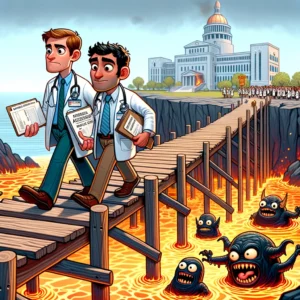
Bucolic afternoon strolls on lovely campuses. Dedicating your life to studying and teaching ideas that you’re passionate about. Tweed jackets, afternoon coffees with smart people, getting paid to read books, and summers off. There are a million things that make academic life attractive and, if you can get it, working as a professor one of the best gigs in the world. I get it. I spent six years at Yale earning my Ph.D., taught at Harvard, and have immense affection for the time I spent in academia. Ultimately, family considerations and a thriving “side hustle” that grew into a prosperous business led me to leave academia behind.
But I still miss is. I’ll never go back… but I miss it.
Given my life and professional trajectory, I’m in a unique position to be frank with people about whether they should get a Ph.D. and pursue life in academia. I don’t think it’s a simple answer; it’s a great life, but also hard to achieve success within. Choosing a career in academia is no small decision. It’s a path fraught with intense study, deep research, and, frankly, a significant amount of uncertainty. For many, the allure of delving deep into a subject they love and contributing to our broader collective knowledge is compelling. However, the reality of academic life often differs from what one might expect. To truly understand if this path is for you, here are ten critical questions to consider before you decide to pursue an academic career.
- Are You Passionate About the Subject?
Passion is the cornerstone of a successful academic career. I sometimes work with clients who seem to want to go to graduate school because they’re not certain about their next life move, and grad school seems like a fun place to park while you figure it out. This is a mistake. Grad school is intense, and after that you’ll spend years—possibly decades—researching, discussing, and teaching your chosen subject. This requires a deep, sustained interest that goes beyond mere curiosity. Ask yourself: Are you ready to eat, sleep, and breathe this subject? Can you envision yourself being just as excited about your field in ten years as you are today? If the answer isn’t an enthusiastic “yes!” then walk away right now.
- Are You Ready to Work Really Hard?
Academia demands a high level of dedication and hard work. This includes long hours of research, writing, and teaching, often while juggling several projects at once. The workload can be intense, with tight deadlines and high expectations. Prepare to push your limits of endurance and time management. Are you ready for this level of commitment? PhD programs in STEM subjects have a 50% dropout rate and in the humanities it’s even lower in the humanities and social sciences. If high-achieving people with demonstrated ability and passion in these fields are mostly not completing their PhDs, that should tell you how much is required to excel within academia.
- Have You Done the Research on What Percentage of PhD Grads Get Tenure-Track Positions?
Let’s assume you beat the odds and complete your Ph.D. The academic job market is notoriously competitive. Only a small percentage of PhD graduates secure tenure-track positions, and many spend years in temporary or adjunct roles. In the year I first went on the job market, I remember a job at Ohio State (a decidedly third-tier university) in my field received over 700 applicants. It has only gotten harder since. Investigate these statistics for your specific field to set realistic expectations about job prospects and the challenges you might face.
- Have You Thought About the Life You’d Live Pursuing Academia?
Life as an academic can be vastly different from other careers. It often involves relocating to where the jobs are, which might mean moving across the country or even abroad. Financially, it might not be as rewarding as other professions requiring similar levels of education. My first job was at Harvard, and I made about $90,000 per year and had great benefits. But many of my classmates from Yale were adjuncts or tenure-track professors at smaller schools, and they typically earned less than $35,000, had onerous teaching loads, bad benefits, and struggled to complete the kind of research and writing that would enable them to climb the ladder. They simply didn’t have the time.
Most people who pursue PhDs envision themselves one day living in Ann Arbor, Berkely, or Durham, with comfortable -though perhaps not lucrative- jobs that are fulfilling and provide them the time and space to think, research, and write. In fact, you’re far more likely to have to take a first job at Southwest Bumblefuck Tech and Trade School in a rural Louisiana bayou town teaching four sections of 75 students each term and making $37,000 per year. Consider whether this lifestyle—the potential instability, relocation, and financial sacrifices—aligns with your personal goals and family plans.
- Do You Have a Clear Sense of the Questions You Aspire to Answer?
A strong academic career is often driven by a clear research agenda. What are the big questions in your field that excite you? Are these questions viable for research and discussion over many years? Your ability to define and pursue these questions can significantly impact your success and satisfaction in academia. Saying “I want to study history,” for instance, is barely more useful than saying, “I want to acquire knowledge and information.” It’s helpful if you can articulate what you expect the title of your dissertation to be, not because that is what you’ll certainly write about (insider tip: nobody ends of writing about the thing they expected to when they arrived!) but because if you don’t have a really granular sense of what you aspire to pursue, you may not be ready to do so.
- Have You Done Anything That Approximates the Kind of Research and Writing You’ll Be Asked to Do in Graduate School?
If you haven’t experienced the rigor of academic research and writing, try to gain exposure before committing to a PhD program. This could involve assisting in research projects, writing papers, or engaging in scholarly discussions. If you’re STEM, lab experience really is necessary, if notyou’re your application, then to ensure that you know what you’re getting into. Such experiences can provide a taste of what your future academic work might entail and help you gauge your readiness and enthusiasm for it.
- Are You Familiar with the Field and the Big Ideas, Controversies, and Schools of Thought Within It? Do You Have a Sense of Where You Would Position Yourself?
Understanding the landscape of your field is crucial. This includes familiarizing yourself with ongoing debates, key figures, and dominant theories. Where do your interests align within these discussions? Having a well-defined stance can help in carving out your niche in a crowded academic environment.
- Do You Have the Grades, Test Scores, Letters of Recommendation, and Background to Earn Admission into a TOP Program?
Admission into top-tier PhD programs is highly competitive. These programs often provide better resources, funding, and job placement outcomes. Assess whether your academic record and references are strong enough to make you a viable candidate for these programs.
- If Not… Are You Willing to Foot the Financial Cost and Face the Steep Uphill Climb of a PhD at a Second-Tier (or Worse) University?
Consider the implications of attending a lower-tier program. When I was applying to PhD programs, my advisor gave me some great advice: you should consider admission without full funding a rejection. As such, if a school didn’t fully fund my doctoral studies, I wouldn’t even consider them. Most top schools fully fund all PhDs as a matter of course, but lower-tier schools offer fewer resources and lower job placement rates, which can affect your career trajectory. Are you prepared for the additional challenges and potential financial burdens this might entail?
- What’s Your Fallback Plan? Yes, Plan for Success… But Don’t Burn the Ship!
It’s wise to have a plan B. The academic path can be unpredictable, and it’s prudent to consider alternative career paths should your initial plans not pan out. What skills can you develop during your PhD that are transferable to other careers? How will you adapt if the academic market does not favor you?
Bluntly, the path forward for a STEM Ph.D. is much rosier than a humanities or social sciences PhD. If you have a doctorate in Cell Biology, for example, there are hundreds of private companies that would hire you at a good salary. A History or Literature PhD, by contrast, doesn’t do much for you in the non-academic job market.
Conclusion
I don’t want this post to feel too negative, but the truth is that when former students come to me asking about pursuing a PhD, my first task is to try to convince them not to. If they hold their ground and answer my questions, then I am more likely to believe they have the onions for the slog. Deciding to pursue an academic career is a significant commitment and should not be taken lightly. By honestly answering these questions, you can better prepare yourself for the realities of the academic world and make a more informed decision. If you succeed, an academic career can be genuinely wonderful, and I still feel a genuine sense of affection for the students I taught and I still miss the beats of an academic year. Just begin the process disabused of the notion that it’ll be a fun idyllic life, prepare yourself for the high chance of failure, and commit yourself to working your ass off.
For more help with your personal statement, check us out at Gurufi.com. Our personal statement editors and consultants have decades of experience helping clients get into top Masters and Ph.D. programs in STEM, humanities, fine arts, and social sciences. Our specialty is helping you craft compelling personal statements that move the needle in your admissions process! For questions, shoot us an email at service@gurufi.com. Check us out on Facebook, Twitter, and LinkedIn.









